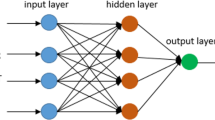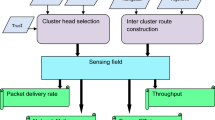Abstract
In order to optimize 3D (Three Dimension) terrain wireless sensor networks, an obstacle sensing fuzzy clustering (OAFC) protocol is proposed to maintain the energy efficiency and data transmission reliability of the network in 3D terrain with obstacles. The location of sensor nodes is determined in 3D environment, and the communication quality of sensor nodes is seriously affected by undulating terrain obstacles. Improving link reliability and reducing energy consumption are key factors for 3D terrain wireless sensor networks. OAFC protocol uses Fuzzy C Means (FCM) technology and Fuzzy inference system (FIS) to search optimal cluster heads (CHs) of network. Fuzzy logic based multi-hop routing is adopted in inter cluster communication to guarantee PDR performance. The performances of OAFC protocol are simulated in three different 3D scenarios. Comparing OAFC with LEACH-3D and FCM-3D, the simulation results show that the total energy consumption of our algorithm nodes is reduced by 17.5% and 33.1% respectively. The number of dead nodes is decreased by 23.6% and 45.9% at most. Packet transfer rate is increased by 0.118 to 0.349. The experimental results show that the more complex the 3D terrain obstacle, the better the performance of OAFC in PDR (Packet Delivery Rate).


















Similar content being viewed by others
Data Availability
The datasets generated during and analysed during the current study are available from the author on reasonable request.
Code Availability
The datasets generated during and analysed during the current study are available from the author on reasonable request.
References
G. Wang, Y. Jiang, X. Cao, X. Li and H. Luo, "Fast Generation of Optimal Topology for 3D Wireless Sensor Networks," 2021 11th International Conference on Information Science and Technology (ICIST), 2021, pp. 614–619.
M. Huang, T. Wang, F. Hou, P. Su, C. Sun and H. Luan, "A 3D TSV-MEMS Based Heterogeneous Integration Technology for RF Application," 2021 22nd International Conference on Electronic Packaging Technology (ICEPT), 2021, pp. 1–4.
N. Boufares, Y. Ben Saied and L. A. Saidane, Improved Distributed Virtual Forces Algorithm for 3D Terrains Coverage in Mobile Wireless Sensor Networks, 2018 IEEE/ACS 15th International Conference on Computer Systems and Applications (AICCSA), Aqaba, Jordan, Oct.28-Nov.1, 2018, pp.1–8.
Z. Wang and H. Xie, Wireless Sensor Network Deployment of 3D Surface Based on Enhanced Grey Wolf Optimizer, IEEE Access, Vol. 8, pp. 57229–57251, 2020.
R. Raj Priyadarshini, N Sivakumar, Failure prediction, detection \& recovery algorithms using MCMC in tree-based network topology to improve coverage and connectivity in 3D-UW environment, Applied Acoustics, Vol.158, pp.107053.1–107053.9, 2020.
M. Zafer, M. R. Senouci and M. Aissani, On Coverage of 3D Terrains by Wireless Sensor Networks, 2019 Federated Conference on Computer Science and Information Systems (FedCSIS), Leipzig, Germany, Sept.2019, pp.501–504.
A.Saad, M. R. Senouci and O. Benyattou, "Toward a Realistic Approach for the Deployment of 3D Wireless Sensor Networks," in IEEE Transactions on Mobile Computing, vol. 21, no. 4, pp. 1508–1519, 1 April 2022.
M. Baghouri, A. Hajraoui, S. Chakkor, Low energy adaptive clustering hierarchy for three-dimensional wireless sensor network, Recent Advances in Communications, pp.214–218, 2015.
Dang Thanh Hai, Le Hoang Son, Trong Le Vinh, Novel fuzzy clustering scheme for 3D wireless sensor networks, Applied Soft Computing, Vol. 54, pp. 141–149, 2017.
A. S. M. S. Hosen, G. H. Cho and I.-H. Ra, An Eccentricity Based Data Routing Protocol with Uniform Node Distribution in 3D WSN, Sensors, Vol. 17, No. 9, pp. 2137, 2017.
F. Al-Salti, N. Alzeidi and B. R. Arafeh, EMGGR: an energy-efficient multipath grid-based geographic routing protocol for underwater wireless sensor networks, Wireless Networks, Vol. 23, No. 4, pp. 1301–1314, 2017.
D. Zhang, W. Shi, R. Elhabyan and M. St-Hilaire, A Coverage and Obstacle-aware Clustering Protocol for Wireless Sensor Networks in 3D Terrain, Computer Communications, Vol. 146, pp. 48–54, 2019.
N. T. Tam, D. T. Hai, L. H. Son and T. Vinh, Improving lifetime and network connections of 3D wireless sensor networks based on fuzzy clustering and particle swarm optimization, Wireless Networks, Vol. 24, No. 5, pp. 1477–1490, 2018.
S. J. Jalal, T. A. Musa, T. H. Ameen, A. Din, W. Aris and J. M. Ebrahim, Optimizing the Global Digital Elevation Models (GDEMs) and accuracy of derived DEMs from GPS points for Iraq’s mountainous areas, Geodesy and Geodynamics, Vol. 11, No. 5, pp. 338–349, 2020.
S. Damien, Y. Blaise Omer, F. Anna, and D. Paul, Optimized Clustering Algorithms for Large Wireless Sensor Networks: A Review, Sensors, Vol.19, No.2, pp.322, 2019.
H. Zhou, S. Xia, M. Jin and H. Wu, Localized and Precise Boundary Detection in 3-D Wireless Sensor Networks, IEEE/ACM Transactions on Networking, Vol. 23, No. 6, pp. 1742–1754, Dec.2015.
E. Shivanian, A Meshless Method Based on Radial Basis and Spline Interpolation for 2-D and 3-D Inhomogeneous Biharmonic BVPs, Zeitschrift für Naturforschung A, Vol. 70, No. 8, pp. 673–682, 2015.
T. Möller, and B. Trumbore, Fast, Minimum Storage Ray-Triangle Intersection, Journal of Graphics Tools, Vol.2, No.1, pp.21–28, 1997.
A. Jain and A. K. Goel, Energy Efficient Fuzzy Routing Protocol for Wireless Sensor Networks, Wireless Personal Communications, Vol. 110, No. 3, pp. 1459–1474, 2020.
S. A. Sert, A. Alchihabi and A. Yazici, A Two-Tier Distributed Fuzzy Logic Based Protocol for Efficient Data Aggregation in Multi-Hop Wireless Sensor Networks, IEEE Transactions on Fuzzy Systems, Vol. 26, No. 6, pp. 3615–3629, 2018.
Acknowledgements
This work was supported by the National Natural Science Foundation of China (62071005, Research on Cooperative NOMA Transmission Key Technologies in Intelligent Surface for Non-ideal CSI), and by the Development Reform Commission of Anhui Province, China (2020478, Research and industrialization of a new generation of intelligent networked autonomous multi-domain display and control system for automobiles).
Funding
This work was supported by the National Natural Science Foundation of China (62071005, Research on Cooperative NOMA Transmission Key Technologies in Intelligent Surface for Non-ideal CSI), and by the Development Reform Commission of Anhui Province, China (2020478, Research and industrialization of a new generation of intelligent networked autonomous multi-domain display and control system for automobiles).
Author information
Authors and Affiliations
Contributions
All authors contributed to the study conception and design. Material preparation, data collection and analysis were performed by YJ. The first draft of the manuscript was written by YJ and all authors commented on previous versions of the manuscript. All authors read and approved the final manuscript.
Corresponding author
Ethics declarations
Conflict of interest
The authors declare that they have no conflicts of interest.
Ethical Approval
This article does not contain any studies with human participants or animals performed by any of the authors.
Consent to Participate
We guarantee that there is no objection to the signature and order of all authors. Multi-unit cooperation manuscripts ensure that there is no objection to the order of the units and no intellectual property disputes.
Consent for Publication
After the manuscript is accepted for publication, the author transfers the various publishing rights of the manuscript (including paper publishing rights, copying, distribution, and publishing rights of electronic media such as CDs, networks, etc.) to the Editorial Department of International Journal of Wireless Information Networks.
Additional information
Publisher's Note
Springer Nature remains neutral with regard to jurisdictional claims in published maps and institutional affiliations.
Rights and permissions
Springer Nature or its licensor (e.g. a society or other partner) holds exclusive rights to this article under a publishing agreement with the author(s) or other rightsholder(s); author self-archiving of the accepted manuscript version of this article is solely governed by the terms of such publishing agreement and applicable law.
About this article
Cite this article
Ding, X., Jin, Y., Ding, G. et al. Obstacle-Aware Fuzzy Clustering Protocol for Wireless Sensor Networks in 3D Terrain. Int J Wireless Inf Networks 30, 30–41 (2023). https://doi.org/10.1007/s10776-023-00590-1
Received:
Revised:
Accepted:
Published:
Issue Date:
DOI: https://doi.org/10.1007/s10776-023-00590-1




